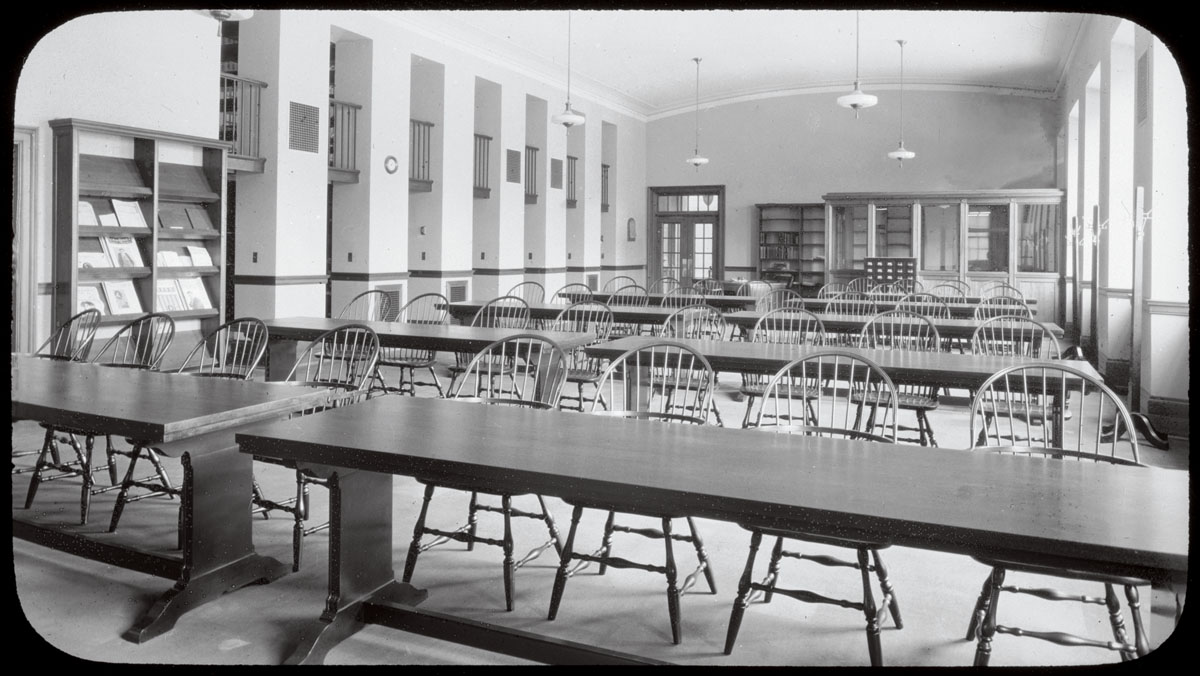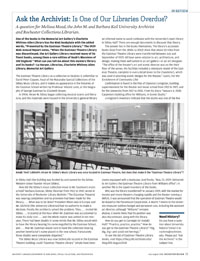In Review
 NAME THAT LIBRARY: Hiram W. Sibley’s Music Library was once located in Eastman Theatre, but does that make it the “Eastman Theatre Library”? (Photo: University Libraries/Department of Rare Books, Special Collections, and Preservation)
NAME THAT LIBRARY: Hiram W. Sibley’s Music Library was once located in Eastman Theatre, but does that make it the “Eastman Theatre Library”? (Photo: University Libraries/Department of Rare Books, Special Collections, and Preservation)Need History?
Do you have a question about University history? Email it to rochrev@rochester.edu. Please put “Ask the Archivist” in the subject line.
One of the books in the Memorial Art Gallery’s Charlotte Whitney Allen Library has the MAG bookplate with the added words, “Presented by the Eastman Theatre Library.” The 1929 MAG Annual Report notes, “When the Eastman Theatre Library was discontinued, the Art Gallery Library received many of its finest books, among them a rare edition of Nash’s Mansions of Old England.” What can you tell me about this mystery library and its books?—Lu Harper, Librarian, Charlotte Whitney Allen Library, Memorial Art Gallery
The Eastman Theatre Library as a collection or location is unfamiliar to David Peter Coppen, head of the Watanabe Special Collections of the Sibley Music Library, and it makes no appearance in the histories of the Eastman School written by Professor Vincent Lenti, or the biography of George Eastman by Elizabeth Brayer.
In 1904, Hiram W. Sibley began collecting musical scores and literature, and the materials were housed in the University’s general library in Sibley Hall (the building was funded by and named for his father, Western Union founder Hiram Sibley).
How did the Sibley’s music collection move to Mr. Eastman’s music school? Barbara Duncan, Sibley librarian from 1922 to 1947, wrote in the University of Rochester Library Bulletin: “The [Eastman Theatre] was nearing completion and no provision had been made for the library. . . . What was to be done? President Rhees was in Europe and Mr. Gilchrist [the University Librarian] had no authority to make a decision. Finally the architects solved the problem. They . . . invited Mr. Sibley . . . to [come] at the hour when Mr. Eastman was accustomed to make his daily visit . . . and the whole matter was settled in ten minutes. There had been doubts in some minds that Mr. Sibley would wish to have the library bearing his name engulfed by the Eastman School, and . . . that Mr. Eastman would care to have the collection bearing another benefactor’s name placed in the new school. Fortunately those doubts were completely dispelled.”
The Sibley Music Library was now technically located in the Eastman Theatre building: could “Eastman Theatre Library” simply have been an informal name to avoid confusion with the University’s main library in Sibley Hall? There are enough documents to discount that theory.
The answer lies in the books themselves. The library’s accession books (kept from the 1850s to 2012) show that about 50 titles from the Eastman Theatre Library were transferred between July and September of 1929. All have some relation to art, architecture, and design, making them well suited to an art gallery—or an art designer: “The office of the theater’s art and scenic director was on the third floor of the annex. His facilities included a miniature model of the Eastman Theatre, complete in every detail (even to the chandelier), which was used in planning scenic designs for the theater.” (Lenti, For the Enrichment of Community Life)
Confirmation is found in the files of Clarence Livingston, building superintendent for the theater and music school from 1922 to 1927, and for the University from 1927 to 1950. From his diary: “January 4, 1928: Carpenters building office for Williams, in Scenic Studio.”
Livingston’s inventory indicate that the studio was one of the few rooms equipped with a bookcase. And finally, “May 23, 1929: Delivered to Art Gallery the Eastman Theatre Library from Williams office”; in another file is the typed inventory of the books.
Why was the library transferred? In January 1929, with the market for movies and movie theaters changing rapidly and the theater running a deficit, it was announced that the operation of Eastman Theatre would be leased to the Paramount Corporation. A March 7 memo to the University treasurer outlines budget and personnel cuts, including the assistant art director; although “Williams” remains elusive, it seems likely that his position was also discontinued, along with the library.
How do you get to Carnegie (or Kodak) Hall? “Practice, practice, practice.” How do you get to the Eastman Theatre Library? “Dig, dig, dig—and avoid red herrings.”
To see the list of Eastman Theatre Library books, visit https://rbscp.lib.rochester.edu/blog/ATA-August2018

